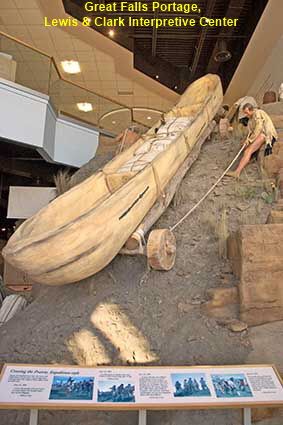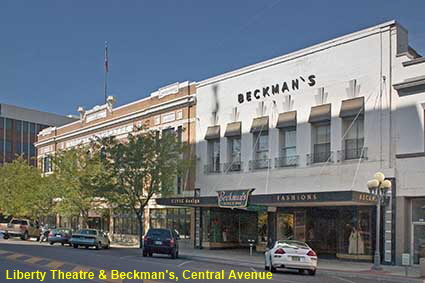Great Falls
In 1803, President Thomas Jefferson set up the Corps of Discovery, an expedition headed by Captain Meriwether Lewis and William Clark to explore the west of the Louisiana Purchase by water find out if there was a route to the Pacific along the Missouri and Columbia Rivers. They began their journey up the Missouri River in 1804 and in June 1805 they came across the biggest barrier that they had yet faced, five separate falls over a 19 kilometre (12 mile) stretch of the river. In 1883 a town was founded at the site of Lewis & Clark’s portage round the falls. The plan was to use the power of the falls and within 6 years, Great Falls had grown into a sizeable centre for commerce, manufacturing and transportation. Today it is a city of over 56,000 people.
Liberty Theatre & Beckman's
Central Avenue in Great Falls has many well preserved old buildings. The Liberty Theatre on the left was built as a cinema in 1921. Today it is used as offices and for retailing. The building on the right was constructed in 1888 and in 1928 it became the home of Beckman’s, originally a furriers who grew into a Department Store that remained in business until the 1990s. The Art Deco facade was added in the 1930s.
Great Falls Portage, Lewis & Clark Interpretive Center
Go to the Visitor Center to ask what you should see in Great Falls and this will be their first recommendation. The Lewis & Clark Interpretive Centre covers the story of the whole Corps of Discovery expedition, from the planning in 1803, through the outward journey from St Charles, Missouri to the Pacific coast in 1804 & 1805 and their return journey back to St Louis, Missouri in 1806. Taking pride of place in the Interpretive Center is this life-sized model of the expedition’s portage around the Great Falls. The falls were a huge barrier to the expedition, not just because of their height but also because they were spread over a 19 kilometre (12 mile) stretch of the river. Lewis & Clark were forced to take their boats overland and it took more than a month of hard physical work to transport the boats above the falls.
Statue of Kid Russell & Monte, Central Avenue
The most famous son of Great Falls is Charles Marion Russell, the cowboy artist. Born in 1864 in Oak Hill, Missouri, the young Russell had dreams of going to the wild west. At the age of 16 he travelled to Montana where he worked first on a sheep ranch and later as a cattle hand, where he was known as “Kid Russell”. Russell started making sketches of life as a cowboy and wrangler which became so popular that after 11 years he retired to become a full time artist. He married in 1896 and the following year he and his wife moved to Great Falls, where he lived until his death in 1926. This 1986 statue in Central Avenue by Buckeye Blake commemorates Russell’s days working as a cowboy and wrangler with his horse Monty (or Monte).
Black Eagle Falls
The five falls faced by Lewis & Clark had a combined drop of 156 metres (512 feet). It was harnessing the hydroelectric power of the falls that allowed Great Falls to prosper with the first dam at Black Eagle Falls providing power for the city from 1890. Today there are five hydroelectric dams in the area, which have drowned some of the falls so the river looks very different from Lewis & Clark’s time.
Click on Minimap to navigate
DLU061120






To move forwards or backwards through the Montana trail click the arrows above, or select your next destination on the Minimap.


© Mike Elsden 1981 - 2025
The contents of this page may not be reproduced in full or in part without permission